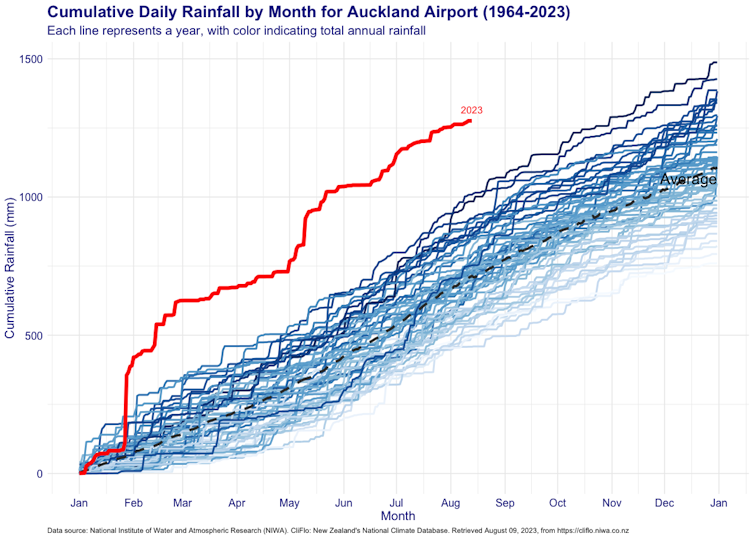Tune into news from about any part of the planet, and there will likely be a headline about extreme weather. While these stories will be specific to the location, they all tend to include the amplifying effects of climate change.
This includes the wildfire devastation on the island of Maui in Hawaii, where rising temperatures have dried vegetation and made the risk that much greater. In Italy, summer temperatures hit an all-time high one week, followed by massive hail storms and flooding the next.
Flooding in Slovenia recently left three people dead and caused an estimated €500 million in damage. At the same time, rainfall in Beijing has exceeded a 140-year record, causing wide-scale flooding and leaving 21 dead.
These northern hemisphere summer events mirror what happened last summer in Auckland, classified as a one-in-200-year event, and elsewhere in the North Island. So far this year, rainfall at Auckland Airport has surpassed all records dating back to 1964.
Given more rainfall is one of the likeliest symptoms of a changing climate, the new report from the Helen Clark Foundation and WSP – Sponge Cities: Can they help us survive more intense rainfall? – is a timely (and sobering) reminder of the urgency of the challenge.
 NIWA, CC BY-NC-ND
NIWA, CC BY-NC-ND
Pipe dreams
The “sponge city” concept is gaining traction as a way to mitigate extreme weather, save lives and even make cities more pleasant places to live.
This is particularly important when existing urban stormwater infrastructure is often already ageing and inadequate. Auckland has even been cutting spending on critical stormwater repairs for at least the past two years.
Politically at least, this isn’t surprising. Stormwater infrastructure, as it is currently built and planned, is costly to develop and maintain. As the Helen Clark Foundation report makes clear, New Zealand’s pipes simply “were not designed for the huge volumes they will have to manage with rising seas and increasing extreme rainfall events”.
The country’s current combined stormwater infrastructure involves a 17,000 kilometre pipe network – enough to span the length of the country ten times. The cost of upgrading the entire water system, which encompasses stormwater, could reach NZ$180 billion.
This contrasts starkly with the $1.5 billion councils now spend annually on water pipes. The report makes clear that implementing sponge city principles won’t wholly solve flooding, but it can significantly reduce flood risks.
Trees and green spaces
The real bonus, though, lies in the potential for sponge city design to reduce dependence on expensive and high-maintenance infrastructure.
There are already examples in Auckland’s Hobsonville Point and Northcote. Both communities have incorporated green infrastructure, such as floodable parks and planted wetlands, which kept nearby homes from flooding.
But the report’s recommendations are at odds with some of the current political rhetoric around land use policy – in particular “greenfields” development that encourages urban sprawl.
The report urges that cities be built upwards rather than outwards, and pushes back on residential infill development encouraged by the Medium Density Residential Standards.
Citing a recent report on green space from the Parliamentary Commissioner for the Environment, the Helen Clark Foundation report argues for the preservation of urban green spaces – like backyards – as part of the flood mitigation approach.
Preserving tree cover is another urgent priority. Trees help absorb rainfall, reduce erosion and provide essential shade and cooling in urban areas – counteracting the dangerous urban “heat island” effect. Citing data from Global Forest Watch, the report states:
Auckland has lost as much as 19% of its tree cover in the past 20 years, Dunedin a staggering 24%, Greater Wellington around 11% and Christchurch 13%.
Incentives for homeowners
Making Aotearoa New Zealand more resilient to extreme weather, the report says, need not break the bank.
It recommends raising the national minimum standards governing the percentage of the total area of new developments that must be left unsealed. This would ensure the implementation of sponge city concepts, and see buildings clustered to maximise preserved green space.
The government should also require local councils to plan for and provide public green spaces, and to develop long-term sponge city plans – just as they do for other types of critical infrastructure.
Neighbourhoods could be retrofitted to include green roofs, permeable pavements and unsealed car parks. Land use and zoning could also encourage more vertical development, rather than sprawl or infill housing.
The government could also provide incentives and education for homeowners to encourage minimising sealed surfaces, unblocking stormwater flow paths, and replacing lawns with native plants and rain gardens.
More extreme weather and intense rainfall is a matter of when, not if. As the Helen Clark Foundation report makes clear, spending future billions is less of a priority than acting urgently now.
Image: https://earth.org/sponge-cities-could-be-the-answer-to-impending-water-crisis-in-china/
Timothy Welch, Senior Lecturer in Urban Planning, University of Auckland
This article is republished from The Conversation under a Creative Commons license. Read the original article.

